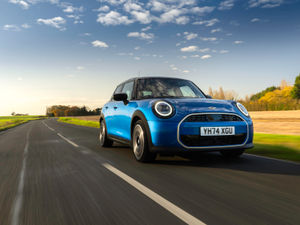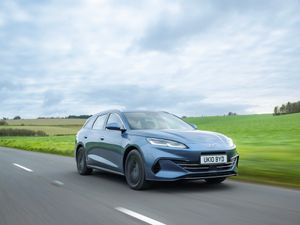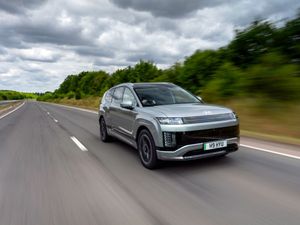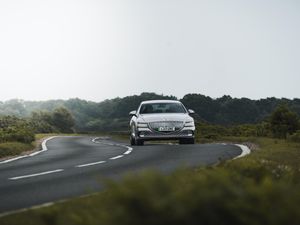Driving the hydrogen-powered Honda Clarity - is this the fuel of the future?
Honda has been investing heavily in hydrogen cars. Darren Cassey heads to Denmark to test the latest fruits of the Japanese manufacturer’s labour.
What’s new?

This is Honda’s updated hydrogen-powered Clarity model. The Japanese manufacturer is expanding the model’s range to include a fully electric, plug-in hybrid and hydrogen variant, making it the first model to offer all three on one platform.
Hydrogen-powered Claritys have been around for a few years, but now there’s a new and improved version, which we’ve been driving. Honda’s engineers have managed to reduce the size of the fuel cell stack and electric drive unit – equivalent to the engine and transmission in a conventional car – without losing any performance, meaning it can now fit under the bonnet. It used to sit beneath the cabin and the result of the new setup is much more space for passengers.
You can’t actually buy one right now, though. Honda is currently running a single-digit fleet in the UK with more cars across Europe. Limited long-term Honda customers have been given the chance to apply to run one, but the plan is to eventually offer it in all showrooms after development testing ends in 2022.
Looks and image

On the outside, the Clarity has a rather odd appearance. It’s a big saloon and the design does nothing to hide this – it looks rather fussy from the front. But there are a number of aerodynamic touches such as the ‘air curtains’ in front of the rear wheels that deserve closer inspection, while the fin-shaped wheel design itself helps improve airflow and looks intriguing.
Considering the size of car required to fit the fuel cell stack and the two hydrogen tanks as well as the high cost of research and development that’s going into the drivetrain, it’s no surprise that the Clarity feels like a premium saloon as Honda can ultimately charge more for the car. Impressively for a brand whose bread and butter is low-cost, mainstream models, the interior is high quality and well put together, while the seats are perfectly comfortable.
Space and practicality

Where hydrogen vehicles have traditionally struggled is offering decent cabin space and room for lots of luggage. By moving the fuel cell stack beneath the bonnet and tweaking the placement of the two hydrogen storage tanks, Honda has massively improved the space on offer.
In the cabin, there’s a large cubby hole between the front seats as there’s no transmission tunnel in the way, while leg room is impressive all around – we had four people in the car at one point and there was plenty of room to spare. Boot space is decent, though the hydrogen tanks do intrude resulting in an odd shape.
Safety is a big talking point with hydrogen due to the high pressures required to store it, but Honda has gone to great lengths to protect the tanks in the event of a crash. Because the Clarity is built for hydrogen and electrification from the ground up, the steel sub-frame could be designed in a way that protects the storage tanks in the event of a rear-end crash and dissipates the energy towards the front of the car. It appears to perform well in rigorous crash tests.
What’s under the bonnet?
This is where the Clarity Fuel Cell gets really interesting, and where the impressively concise PowerPoint presentation we were given prior to our drive in Copenhagen, Denmark, becomes invaluable.
Uniquely for a hydrogen-powered car, under the bonnet of the Clarity sits the full powertrain. The fuel cell stack and drive unit are packaged together in a setup that’s slightly smaller than the company’s 3.5-litre petrol V6 engine.
Hydrogen and air are fed to the unit, with the fuel cells generating electricity. A voltage control unit then boosts the voltage and provides the drive unit with electricity. There are lithium-ion batteries beneath the cabin that also store electricity and provide it to the drive unit to boost performance under acceleration.
The result is 174bhp and 300Nm of torque. It’s not fast by any means, but in normal driving it never feels lacking.
Behind the wheel

The best compliment you can pay the Clarity Fuel Cell is that it drives just like any other electric car. Because it runs on electricity it’s mostly silent, save for some whirring on deceleration as regenerative braking kicks in to refill the batteries. A Honda employee told us that removing the loud whirring and whistling anyone who’s ever been on a hydrogen-powered London bus will be familiar with was a top priority.
Out on the road it’s perfectly happy bumbling about and never feels lacking in puff should a motorway overtake be required. It also feels slightly more responsive than fully electric vehicles when accelerating on the move, thanks to the fuel cell/battery combination.
A nice touch we hope becomes commonplace is a blind spot camera. When indicating towards the offside, a live video feed of your blind spot appears making changing lanes a doddle. We’re told there are no plans for it in the UK yet as it’s there for new American legislation, which is a shame.
Value for money

You can’t buy one and it’s impossible to say what the price might be for a car we probably won’t see on sale until the mid- 2020s. However, compared to similar cars in this segment the Clarity holds its own materials-wise.
The one bug-bear we desperately hope Honda has improved by the time the Clarity goes on sale is the infotainment system. It’s slow, illogical to navigate through menus and comes with hopelessly outdated graphics.
Who would buy one?

Of the three Clarity models that’ll eventually be on sale, the plug-in hybrid is expected to be the volume seller. The Fuel Cell version will hope to draw the likes of BMW 5 Series owners to the green side by offering the best range of any zero-emission vehicle – 403 miles under NEDC regulations. We’re told that high-end taxi and chauffeur companies have been very interested.
The end goal, though, is to make the Fuel Cell a viable option across the Honda range for a variety of buyer profiles. The powertrain is already smaller than some of its traditional engines, which opens opportunities for existing models to have hydrogen-powered variants.
Verdict

Honda’s biggest hurdle with its push for hydrogen-powered transport is infrastructure. Currently in the UK there are only a handful of filling stations, but if the initiatives Honda and other manufacturers are working on are successful, that number will grow and make fuel cell cars a viable alternative.
As for the car? Well, the perhaps underwhelming verdict from behind the wheel is that the future drives a lot like the past. However, the silence of electrification is always welcome, while the low running costs and undeniable green credentials will also appeal. The future of the car is promising.
FACTS AT A GLANCE
Model: Honda Clarity Fuel Cell
Base price: N/A
Engine: Fuel cell stack with electric drive unit
Power: 174bhp
Torque: 300Nm
Max speed: 103mph
0-60mph: 8.8 seconds
Range: 403 (NEDC, claimed)
Emissions: 0g/km





